Prev Post
Empowering Global Development, Join the 2023 UN Datathon with the Debut of China Division!

On March 18, 2022, a paper entitled "Frequency Dependent Polarization of Repeating Fast Radio Bursts - Implications for Their Origin" was published in the journal Science, which pointed out that repeated fast radio bursts (FRBs) are in a complex environment similar to supernova remnants.
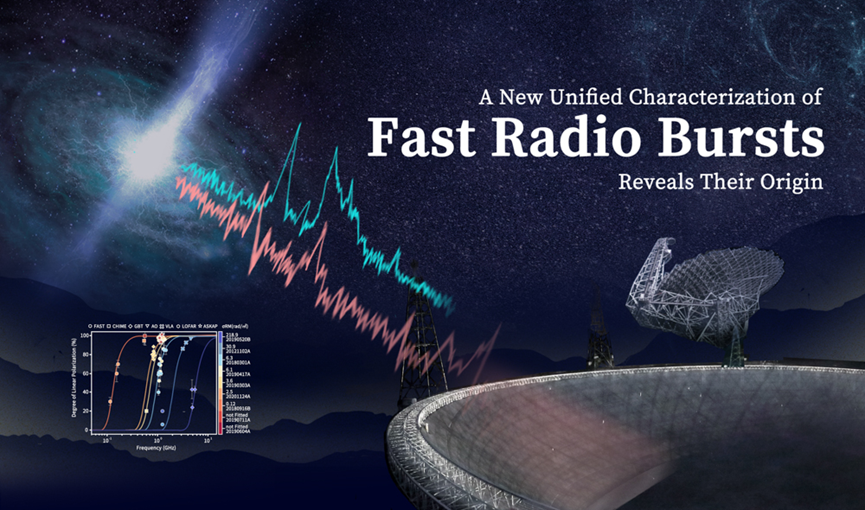
Taking an innovative approach, this paper studies the surrounding environment of FRBs through the relationship of polarization frequency evolution, and, for the first time, proposes a unified mechanism that can explain the polarization frequency evolution of repeated FRBs, providing key observational evidence for a bulk of theoretical models to distinguish the origin of repeated FRBs. FENG Yi, a Research Expert at the Research Center for Intelligent Computing Platform of Zhejiang Lab (ZJ Lab), is the sole first author of the paper. LI Di, Chief Scientist of Computational Astronomy at ZJ Lab, is the sole corresponding author of the paper.
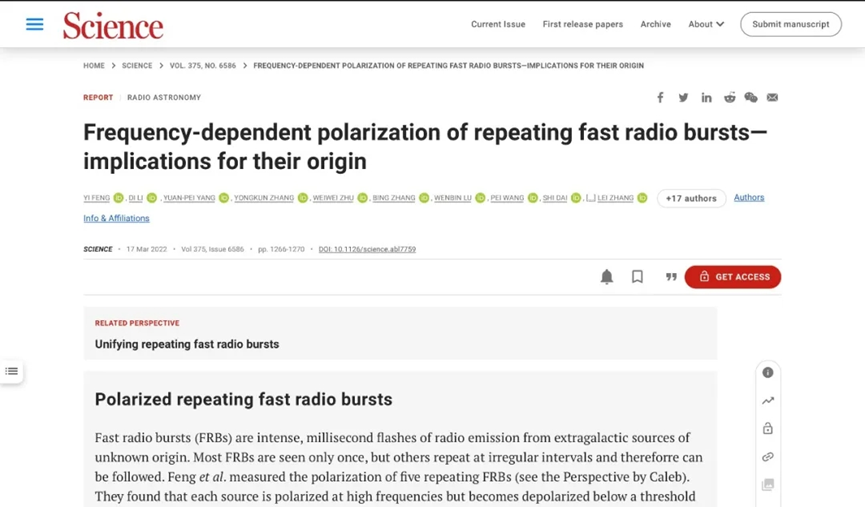
FRBs, a sort of huge bursts of radio waves that last only a few milliseconds in the distant universe, can release as much energy as the sun does in a whole day. Since radio astronomer Professor Duncan Lorimer and his team first discovered fast radio bursts in 2007, this new astrophysical phenomenon has become a hot spot in the field of astronomy. According to observations, some FRBs could erupt repeatedly.
For the origin of this "mysterious signal" deep in the universe, scientists have varying theoretical assumptions - giant magnestar bursts, giant pulsar pulses, neutron stars through the asteroid belt, binary black hole mergers... These high-energy events are considered possible sources of fast radio bursts.
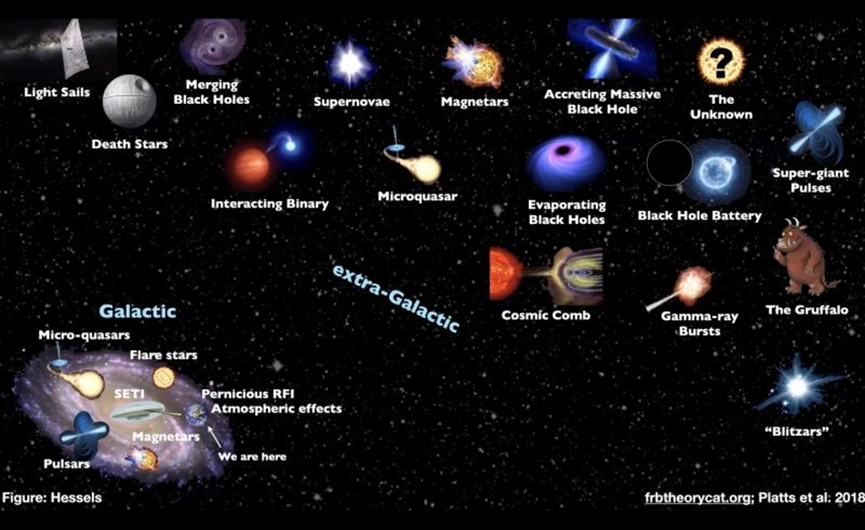
The conjecture on the origin of FRBs Source: Jason Hessels
It remains extremely difficult to find the origin of FRBs deep in the universe. "Based on the existing astronomical equipment, it is hard to directly observe the details of the origin beyond the Milky Way." FENG Yi said.
"The vast majority of FRBs have signals only in the radio band, with a lack of multi-band observations to provide additional information. In the past, we waited and contrived to identify the counterpart, but even if the burst was detected, it was hard to determine its basic physical mechanism because of the long distance," FENG Yi further explained.
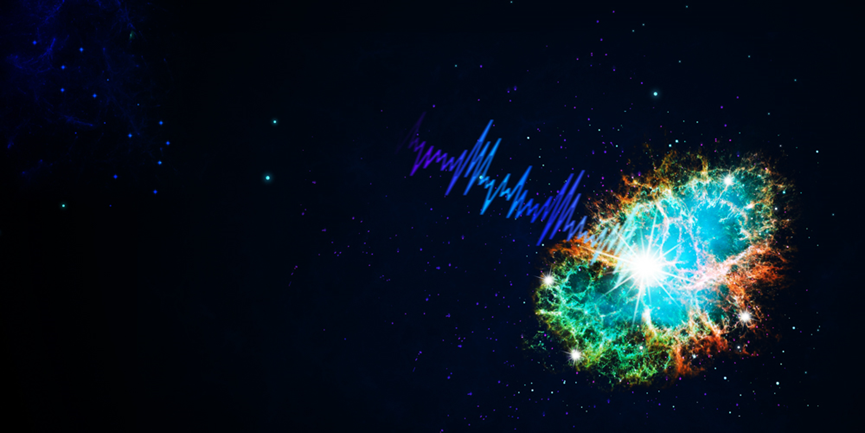
"During the propagation of an FRBs signal, the polarization characteristics are affected by the surrounding interstellar medium. By analyzing the polarization characteristics of the FRBs, we can limit its radiation mechanism and speculate on the magnetic flux density and number density of electrons of the medium it passes through," LI Di pointed out.
After systematically analyzing the polarization characteristics of a group of repeating FRBs with the "China Tianyan" FAST and the U.S. GBT, FENG Yi and other researchers found that the repeating FRBs in the sample were characterized by low linear polarization at low frequency and high linear polarization at high frequency. This special relationship of frequency evolution indicates the perplexing environment of the FRBs origin in the sample, which, featuring strong magnetic fields and high electron number density, is consistent with the environmental characteristics of supernova remnants and pulsar clouds. In other words, these FRBs are most likely in supernova remnants, pulsar clouds, and other environments.
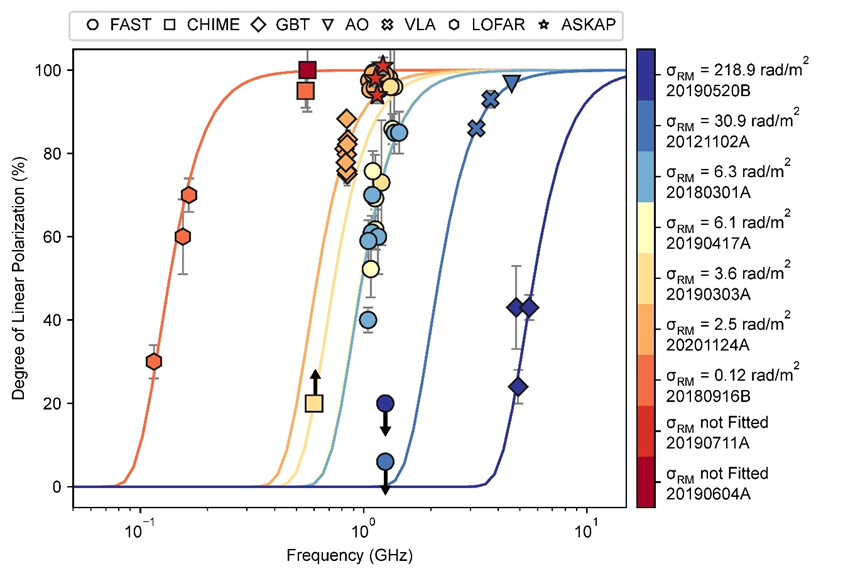
The relationship of the evolution of the polarization frequency of repeating FRBs. The lines with different colors represent the polarization evolution curves of different FRBs with frequency. Each line is fitted with only one parameter σRM. The greater the σRM, the more complex the environment in which FRBs occur.
According to the figure, the linear polarization of repeating FRBs presents a uniform tendency to decrease with decreasing frequency, and this frequency evolution relationship can be quantified by a single parameter "RM dispersion (σRM)". This rules out other explanations, including intra-channel depolarization and intrinsic frequency evolution models of pulsar polarization based on changes in the height of the magnetosphere in the radiating region. Based on this, LI Di's team, in collaboration with Professor YANG Yuanpei from Yunnan University, Dr. LU Wenbin from Princeton University, and Professor ZHANG Bing from the University of Nevada, built a medium model based on multipath scattering, which can further constrain the spatial scale, density fluctuations, magnetic field configuration, and other substantial physical properties of the radiation region.
According to LI Di, this work fully combines FAST's advantages of high sensitivity and the rich observation resources at the forefront of FRBs, an international hot spot, and provides a crucial observation foundation for constructing a complete origin model of FRBs. FAST's continuous in-depth monitoring, combined with other advanced equipment, is expected to answer a series of key questions about the origin of FRBs in the next 2-3 years, such as whether there is a unified origin of repeating and non-repeating FRBs.
At present, ZJ Lab is working on building an astronomical intelligent computing platform based on FAST, which will leverage intelligent computing and artificial intelligence technology to accelerate scientific research in the field of astronomy.
"Utilizing intelligent computing, we can conduct deep analysis of the sampling data of FAST high-time-frequency cosmic signals, detect the radiation phenomena of the world's shortest target celestial objects, and explore the 'time frontier' of the universe, striving to understand the origin of FRBs." LI Di said.
The research has been published in the journal Science.
Article link: www.science.org/doi/10.1126/science.abl7759
News Background:
A supernova is a violent explosion that some stars experience near the end of their evolution. These explosions are extraordinarily bright, with a burst of electromagnetic radiation that can often illuminate the entire galaxy and last for weeks to months before fading. During this period, a single supernova can emit as much radiation as the sun does in its lifetime. Stars can blast most or almost all of their material outward at a speed as fast as one-tenth the speed of light and radiate shock waves into the surrounding interstellar material. This shock wave would lead to the formation of a shell of expanding gas and dust, which is called a supernova remnant.
Driven by winds generated by the central pulsar, the pulsar cloud is a nebula found within the shell of a supernova remnant. Pulsars are high-speed rotating neutron stars with strong magnetic fields formed in the process of a supernova explosion in the late life of massive stars, with a radius of only about 10 kilometers and a typical magnetic field of about one trillion gauss, equivalent to two trillion times the Earth's magnetic field.











